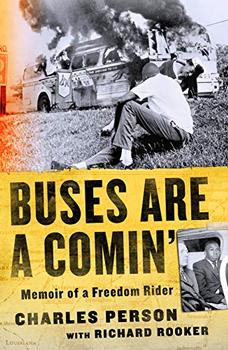Summary | Excerpt | Reading Guide | Reviews | Beyond the Book | Read-Alikes | Genres & Themes | Author Bio

Memoir of a Freedom Rider
by Charles Person, Richard RookerThis article relates to Buses Are a Comin'
 In his memoir Buses Are a Comin', Charles Person explains that he got involved with the American Civil Rights Movement of the 1950s-1960s through fellow students at his school, Morehouse College, which is one of the country's oldest Historically Black Colleges and Universities (HBCUs).
In his memoir Buses Are a Comin', Charles Person explains that he got involved with the American Civil Rights Movement of the 1950s-1960s through fellow students at his school, Morehouse College, which is one of the country's oldest Historically Black Colleges and Universities (HBCUs).
The HBCU designation was created by the Higher Education Act of 1965, which defines an HBCU as "any historically black college or university that was established prior to 1964, whose principal mission was, and is, the education of black Americans, and that is accredited by a nationally recognized accrediting agency or association."
The first all-Black institute of higher learning in the American South was Shaw University, founded in Raleigh, North Carolina in 1865 by Henry Martin Tupper. A Massachusetts native, Tupper was a chaplain for the Union Army during the Civil War, and became aware of how slavery had impacted African Americans. He began teaching Black men in Raleigh to read and write, and eventually bought a plot of land with savings from his military service, along with funds from organizations such as the Freedman's Bureau. There, he and his students constructed a two-story building that served as both church and school.
Other early HBCUs include Talladega College, Howard University and Morehouse College, which all opened in 1867. The second Morrill Act, passed by Congress in 1890, gave a further boost to the effort behind providing education to Black Americans. Aimed particularly at former Confederate states, the act required that land grants be provided to institutions of higher learning for Black students if admission wasn't available to them elsewhere (as it typically wasn't, since most colleges in the South refused to enroll Black students). By 1900, there were more than 90 higher learning institutions for Black people in the United States.
Black Americans made organized efforts to push back against segregation and racism in the 1950s, and HBCUs became important centers for the nascent Civil Rights Movement. According to the web site HBCU Lifestyle, "Not only did HBCUs produce some of the great leaders of the movement, including Medgar Evers (Alcorn State), Rosa Parks (Alabama State), Stokely Carmichael (Howard University), and Dr. Martin Luther King, Jr. (Morehouse College), they were also indispensable centers of the fight for equality." Young people met in dorm rooms and rec centers to plan sit-ins, boycotts and marches with the support of the institutions' teachers and administrators. A TIME Magazine article covering the historical connection between protest culture and HBCUs notes, "The Student Nonviolent Coordinating Committee, which fought segregation, was formed after a conference of 300 students at North Carolina's Shaw University. Four students at North Carolina A&T State University in Greensboro launched the sit-in movement at a nearby lunch counter. Congressman John Lewis, then a student at Fisk University in Tennessee, was one of the original 1961 Freedom Riders, who galvanized civil rights protests across the nation."
As of 2018 there were 101 HBCUs in the United States — 51 public, 50 private non-profit — with a combined enrollment of just under 300,000 students. Over time these schools have become integrated, with Black people making up 24% of the student body at present — the small percentage due, in part, to Black students now being allowed admission at all US schools, giving them more options for higher education.
Some have questioned whether HBCUs are still relevant, given the current degree of racial integration in United States universities, but they continue to serve an important function. They have a higher retention rate of minority students than other schools, and they often offer better financial assistance, allowing those with fewer resources to attend. HBCUs also assist Black Americans with getting into STEM fields; 65% of all Black physicians and half of all Black engineers graduated from an HBCU. Perhaps most importantly, HBCUs continue to support racial equality movements such as Black Lives Matter, providing a structure for discussion and protest surrounding issues relevant to Black students. As Matthew Lynch notes in an article for the Edvocate compiling some of these arguments and more, "There are still battles to be fought." HBCUs are a crucial part of the effort.
Graduates of Morehouse College in Atlanta, Georgia react to remarks made by President Barack Obama during the commencement ceremony on May 19, 2013. By Pete Souza, Official White House Photo
Filed under Places, Cultures & Identities
![]() This "beyond the book article" relates to Buses Are a Comin'. It originally ran in May 2021 and has been updated for the
January 2022 paperback edition.
Go to magazine.
This "beyond the book article" relates to Buses Are a Comin'. It originally ran in May 2021 and has been updated for the
January 2022 paperback edition.
Go to magazine.
We have to abandon the idea that schooling is something restricted to youth...
Click Here to find out who said this, as well as discovering other famous literary quotes!
Your guide toexceptional books
BookBrowse seeks out and recommends the best in contemporary fiction and nonfiction—books that not only engage and entertain but also deepen our understanding of ourselves and the world around us.